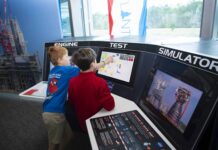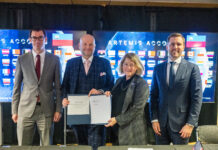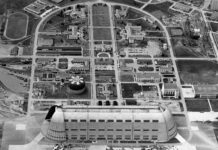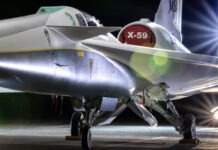NASA and SpaceX Progress Toward Artemis III and Beyond
NASA, in collaboration with its industry partners, is making significant strides toward the Artemis III mission and subsequent lunar expeditions. As part of NASA’s Artemis campaign, these missions aim for the first crewed lunar landings. SpaceX, a key player in this endeavor, recently conducted critical testing with a scale model of their Super Heavy rocket at NASA’s Ames Research Center. This model underwent rigorous evaluations in the Unitary Plan Wind Tunnel to simulate the aerodynamic challenges the rocket will face during actual flight.
Wind Tunnel Testing: A Key Milestone
The wind tunnel tests involved a 1.2% scale model of the Super Heavy booster. Engineers exposed the model to high-speed air streams, replicating the conditions the rocket will face during its journey. These tests subjected the model to wind speeds between Mach 0.7 (approximately 537 miles per hour) and Mach 1.4 (around 1,074 miles per hour). To provide some context, Mach 1 is the speed of sound, about 761 miles per hour at sea level.
The primary objective was to monitor the model’s stability, aerodynamic performance, and overall response to these simulated conditions. Engineers equipped the model with pressure sensors to gather precise data, which they will use to refine flight software and improve the booster design for future missions. This phase of testing, which lasted two weeks, was crucial for ensuring the reliability and safety of the Super Heavy rocket.
Artemis Mission Workflow
For the Artemis missions, astronauts will launch aboard NASA’s Orion spacecraft, propelled by the Space Launch System (SLS) rocket from Kennedy Space Center. Once in lunar orbit, Orion will dock with either the Starship Human Landing System (HLS) or the lunar Gateway. The Gateway is a future lunar space station that will act as a staging point for missions to the Moon and beyond. The astronauts will transfer from Orion or Gateway to the Starship HLS, which will then transport them to the Moon’s surface.
After completing their surface activities, the Starship HLS will return the astronauts to Orion or Gateway in lunar orbit. The final stage involves transferring the astronauts back to Orion for their journey back to Earth. This intricate sequence of maneuvers is designed to maximize safety and efficiency.
SpaceX’s Reusability Plans
The Super Heavy booster, after completing its task of launching the Starship HLS to the Moon, is designed to return to the launch site for recovery and reuse. This approach aligns with SpaceX’s broader strategy of developing reusable rocket technology, which aims to reduce costs and increase the frequency of space missions.
Broader Goals and Technological Foundations
The Artemis program represents a significant leap in human space exploration. NASA aims to explore more of the Moon than ever before, develop the ability to live and work on another celestial body, and prepare for future human missions to Mars. The foundational technologies for these endeavors include the SLS rocket, Orion spacecraft, human landing systems, next-generation spacesuits, and lunar rovers.
NASA’s Marshall Space Flight Center manages the HLS and SLS programs, ensuring that these critical components are developed and integrated effectively.
Boeing’s Starliner Test Flight: A Step Toward Crew Missions
NASA and Boeing recently concluded a three-month flight test of the uncrewed Starliner spacecraft. The mission ended with a safe landing at White Sands Space Harbor in New Mexico. This test provided invaluable data, even though the spacecraft returned without a crew due to identified technical issues during its approach to the International Space Station (ISS).
Importance of the Test Flight
The test flight, which launched on June 5, was significant as it marked the first time astronauts were onboard the Starliner. Despite the decision to return the spacecraft uncrewed, the mission offered critical insights into the Starliner’s performance in extreme conditions. NASA and Boeing are now analyzing the data to certify Starliner for regular crew rotation missions to the ISS.
Learning and Future Missions
Steve Stich, manager of NASA’s Commercial Crew Program, highlighted the importance of this mission in setting the stage for future Starliner flights. Astronauts Butch Wilmore and Suni Williams, who launched aboard Starliner, will continue their mission aboard the ISS as part of Expedition 71/72, with their return planned for February 2025 via SpaceX Crew-9.
The Commercial Crew Program aims to provide safe, reliable, and cost-effective transportation to and from the ISS and low Earth orbit. This initiative not only facilitates additional research but also prepares NASA for future exploration missions to the Moon and Mars.
Innovations for NASA’s Artemis IV Mission
As NASA prepares for deep space missions, ensuring astronauts’ well-being is paramount. Engineers at NASA’s Marshall Space Flight Center are developing innovative solutions like the Mini Potable Water Dispenser for the Artemis IV mission. This device, designed to be compact and manual, will provide water for hygiene, food rehydration, and drinking, making it ideal for the confined space of the Gateway lunar space station.
Enhancing Astronaut Well-being
Shaun Glasgow, project manager at Marshall, emphasized that food in space is more than just sustenance; it provides psychological comfort. Devices like the water dispenser will help maintain a sense of normalcy for astronauts, allowing them to enjoy familiar meals in an otherwise alien environment.
International Observe the Moon Night
NASA invites the public to join the International Observe the Moon Night on September 14. This annual event encourages global appreciation and understanding of the Moon and its connection to NASA’s exploration efforts. The celebration will feature various activities, including telescope viewing, hands-on STEM activities, and science shows.
Artemis Hardware Arrives at Kennedy Space Center
Key components for the Artemis missions recently arrived at Kennedy Space Center from across the globe. ESA’s European-built service module for the Artemis III mission completed its journey from Germany to Florida. This module, crucial for providing propulsion, thermal control, and life support, will be integrated with NASA’s Orion spacecraft.
Collaborative Efforts
NASA’s Pegasus barge transported significant hardware, including the SLS rocket components and ground support equipment, to Kennedy Space Center. These components are essential for the upcoming Artemis II and III missions.
Discoveries in Astronomy
Astronomers using NASA’s Hubble Space Telescope and Chandra X-ray Observatory have identified the closest pair of supermassive black holes, located about 300 light-years apart. This discovery provides a unique insight into the dynamics of galaxy mergers and the behavior of black holes.
Implications for Future Research
The finding, detailed in The Astrophysical Journal, offers a rare glimpse into the early universe’s conditions when galaxy mergers were more frequent. Future missions like the Laser Interferometer Space Antenna (LISA), led by ESA with NASA’s collaboration, will further our understanding of such phenomena by detecting gravitational waves from deep space.
Betelgeuse: The Runaway Star
Betelgeuse, the red supergiant star in Orion, is a runaway star traveling away from its birthplace at high speed. This star, much larger and more massive than our Sun, is nearing the end of its life and is expected to go supernova in the next 100,000 years. Recent studies and observations continue to unravel the mysteries surrounding Betelgeuse’s behavior and its impact on our understanding of stellar evolution.
BurstCube’s First Gamma-Ray Burst Detection
NASA’s BurstCube satellite has detected its first gamma-ray burst, marking a significant achievement for the mission. Despite challenges with its solar panels, the team has successfully gathered valuable data on short gamma-ray bursts, enhancing our understanding of these powerful cosmic events.
Conclusion
NASA’s ongoing efforts in space exploration, from the Artemis lunar missions to groundbreaking astronomical discoveries, continue to push the boundaries of human knowledge and capability. These advancements not only pave the way for future missions to the Moon and Mars but also contribute to our understanding of the universe. As we look forward to upcoming milestones, the collaborative efforts of NASA, industry partners, and international agencies remain crucial to the success of these ambitious endeavors.
For more Information, Refer to this article.


































